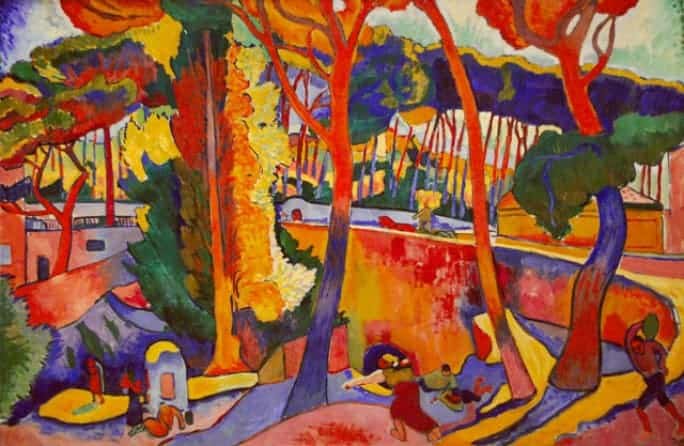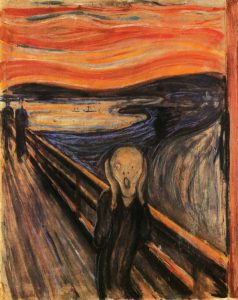1898 – 1920
Expressionism is one of the earliest avant-garde art movements, and this art movement was centered on the expression of feeling through intense color.

The Fauves worked this through clashing color, distorted forms, alien perspectives, rough brushstrokes, and flat linear patterns on canvases that weren’t always completely covered.
The Expressionists took these ideas and worked in violent colors to show emotional angst, abstracted their forms, and attempted to express modern and contemporary ideas through emotional subject matter.
These two movements – fauvism and expressionism – were some of the first examples of abstract art, only barely predating Cubism, another influential modern art movement.
Expressionism
Expressionism’s origins are debated; however, the two main groups were created around 1905 in Germany in reaction to the effect of industrialization and urbanization on the human condition.
The German Expressionists rejected realism in favor of the representation of emotion and shared many other ideals with other avant-garde movements of the time such as Fauvism, Cubism, Futurism, Dadaism, and Surrealism.

One of the German groups, Der Blaue Reiter, lasted for the year of 1912.
Comprised mainly of expatriate Russians living in Germany, the artists strove to express spiritual truth within their art, to remain free of strict or traditional artistic values, to promote modern art, and to be spontaneous.
This kind of painting with its large frames is a bourgeois drawing-room art. It is an art dealer’s art-and that came in after the civil wars following the French Revolution”. – Edvard Munch
They were influenced and inspired by medieval art and primitivism and as they grew were influenced by other avant-garde movements toward abstraction.
There is nothing more difficult for a truly creative painter than to paint a rose, because before he can do so he has first to forget all the roses that were ever painted. – Henri Matisse
The other group, Die Brücke, is more closely related to Fauvism and is often compared to it because of their shared interest in primitivist art, emotional expression through intense unnatural color, and neither was fully abstract.
The defining difference was in the subjects and settings. Die Brücke was bolder and dealt with more intense and discomforting subjects.
What is Abstract Expressionism? – Expression and Vitality Over Perfection?
Fauvism and Expressionism – Key Differences and Highlights:
- Fauvism was originated in France in the early 20th century, while Expressionism origin simultaneously in Germany and New York
- The Fauves were spontaneous with bright, vivid and colorful strokes, while expressionists used were thoughtful and well planned to ensure that they reflect their inner senses and emotions effectively.
- Fauves enjoyed and promoted collaboration, for which one reason there is a lot of debate around calling it as an art movement.
- Famous fauvism artists were Matisse and Paul Signac. Famous expressionists are Edward Munch and Emily Carr
- Maurice de Vlaminck “loved Van Gogh more than his own father” and after seeing his worked ditched his palette and began squeezing his paint right onto the canvas
- The first true Fauvist painting was completed by Matisse in the summer of 1904. The elements of the painting are the first to coalesce in the Fauvist style.
- The first four members of Die Brücke were architecture students that were interested in art and wanted to create a bridge they would form with the art of the future. The name of the group translates to “The Bridge”.
Top Expressionism Works:
- The Scream – Edvard Munch
- View of Toledo – El Greco
- Jeanne dans les fleurs – Raoul Dufy
- Self Portrait – Andre Derain
- Charing Cross Bridge – Andre Derain
- At the Circus – Georges Rouault
- Yacht at Le Havre Decorated with Flags – Raoul Dufy
- Mountains at Collioure – Andre Derain
Although, the similarities between fauvism and expressionism remains so close, the impact that expressionism created was the last longing and further led to more forms of art
[html_block id=”9474″]

